This is a politicized summary of a project I’ve been doing at the Pomona College Natural Farm, an urban one-acre farm in southern California and the subject of a previous essay here. The focus of this essay will be mustard, and mustard-growing. There will be more such essays.
My interest in mustard (the plant, not merely the food) started with a garden I planted in the front yard of a friend of mine. This was a strategically-placed front yard, near a major intersection of two boulevards, where everyone could see. One of the things I noticed about this garden was that I could get incredible results out of mustard-growing; tiny seeds which produced huge plants. (This, indeed, is why mustard is so noted in a New Testament parable (Matthew 13:31-32).) I could also grow some wild-looking food plants in a really in-your-face location there. How’s that for the politics of mustard?
At some point, I started to think about producing mustard as an edible, tasty, nutritious weed. This Spring at the Pomona College Natural Farm, on the east “adjunct” portion of the Farm, there is a preserved field of weeds, and the dominant weed in this field is… that’s right… mustard. Not the type you put on your hot dog (Brassica nigra or Brassica juncea), nor the type that makes up “mustard greens” (Brassica juncea), nor a special oriental mustard which shares a species with turnips and bok choy (Brassica rapa), but, rather, wild mustard (sometimes labeled Brassica campestris, sometimes Sinapis arvensis).
Now, I remember reading in an article in the journal Plant Breeding (“Hybridizations among Brassica napus, B. Rapa, B. Juncea and their two weedy relatives B. nigra and Sinapis arvensis under open pollination conditions in the field,” Plant Breeding 115, 470-473 (1996)), that suggested that wild mustard and domesticated mustard did not crossbreed. So I haven’t tried to crosspollinate those mustards. But I will be trying to do at least one crosspollination exercise this semester at the Farm.
I am so interested in mustard these days for several reasons. First off, mustard seeds are rather small, thus rather cheap as an eventual source of food if you are buying by weight. (I can especially recommend Peaceful Valley as a good deal on seed.) This is an important consideration if you are gardening on a budget. (NOTE TO GROWERS: there really isn’t supposedly much time left in the growing season this year, as mustards are a cold-season vegetable. But this depends upon where you live — here in southern California it gets hot plenty.) Second, mustard grows easily and produces a lot of food, which is high in vitamins A and C. Third, mustard is a tough plant; it’s frost-resistant, which means that mustard is often the main surviving crop in unusually cold southern California winters. Fourth, I’d like to see if some of the cultivars of mustard that I’m working with will spread as weeds. If people are to “live off of the land,” as is one of my goals, then they should be able to eat weeds.
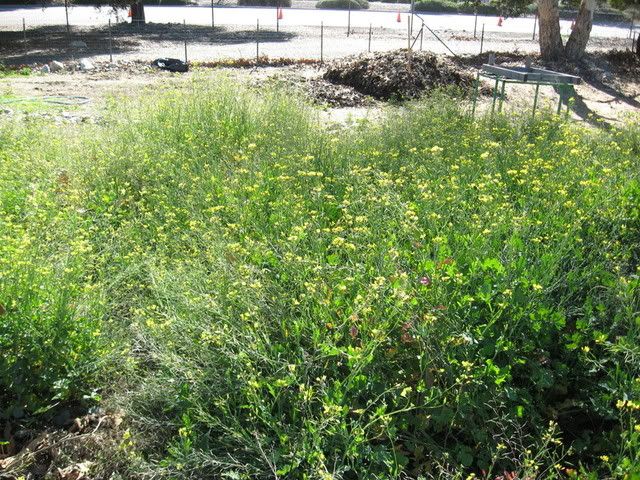
Here is wild mustard, which my friend Brian tells me is growing all over the Chino Hills. This is indeed edible mustard, but not very tasty and not very filling.
**********
This winter, the main edible weed to spring up in Los Angeles County is malva, a type of mallow. Malva is edible, mind you, but it’s bland; and so I think it’s reasonable that we begin to cultivate weeds which have some spicy kick to them; thus mustard.
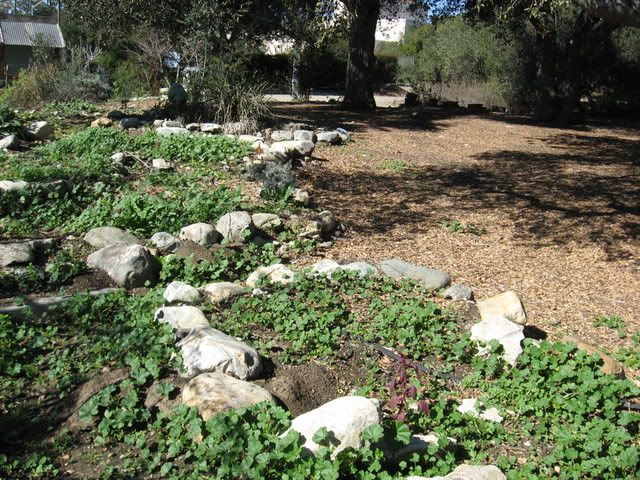
Malva grows everywhere; in February there were big fields of it growing everywhere in southern California. Here is the space just north of the Pomona College Natural Farm, under the oak trees.
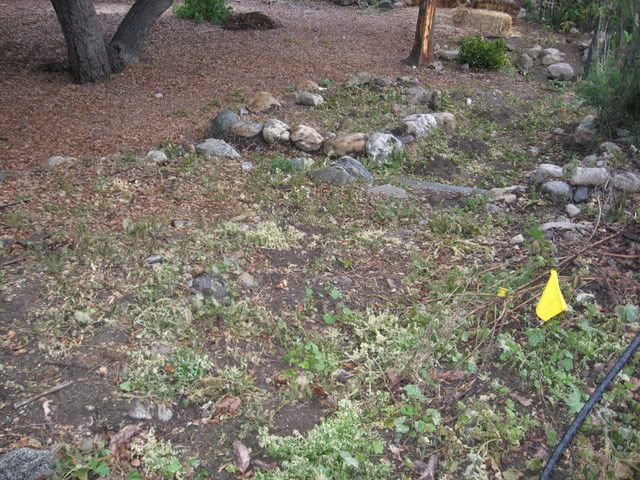
Apparently grounds maintenance spread some kind of herbicide over this malva at some later point, because here’s the same field later, mostly dead. Malva is often regarded as an invasive, non-native species; yet removing this malva could have been done through weeding, or with a “weed-whacker.” Or, hell, they could have just made a big salad out of the stuff, and eaten it. If the Pomona College Farm really wishes to be an “organic” farm, they can’t be using chemical herbicides being used near the Farm itself. (I have no idea which herbicide they used, whether chemical or natural.)
**********
Now, malva has medicinal uses; many of them are listed on the Plants for a Future webpage. But my real interest here is mustard. There’s plenty of malva out there; weeded areas need to have a weed which is versatile, and I think of mustard as that weed. Mustard, especially cultivated mustard, has numerous practical uses; if we are to spread the practical growing of plants to the people of this area (and especially to those who wish to live well on low monetary incomes) we will need to be spreading practical plants such as mustard.
There will be a social agenda to my experiments with mustard. So many people play so little part in the global money economy because they have so little money. If we are to create spaces outside of the money economy, spaces in which people can “live off of the land” even in cities, we must (among other things) spread varieties of plant and animal which can enable ordinary people to live cheaply, or to live off of the money economy altogether. This will mean an aggressive guerrilla gardening program; and it will mean finding and using plants as vehicles for people to “get by.” I can see a series of articles in this vein: this one is about mustard, but the next one could be about garlic, or peas and beans, or maize, or another plant essential to living.
The word “mustard” comes from Latin: the Romans used to mix unfermented grape juice, or “must,” with mustard seed until it acquired that “burning” flavor, thus the Latin name “mustum ardens” or “burning wine,” which was later shortened to “mustard.”
Now, so far I have been using the mustard I’ve grown at the Farm to cook and eat. The Giant Southern Curled mustard is quite spicy, so I prefer to cook it. The tendergreens, which have a spoon-shaped leaf, are also a mustard, and I’ve stashed a bowl, a fork, and a bottle of balsamic vinegar to eat them in impromptu salads. My most successful tendergreens are pictured below.
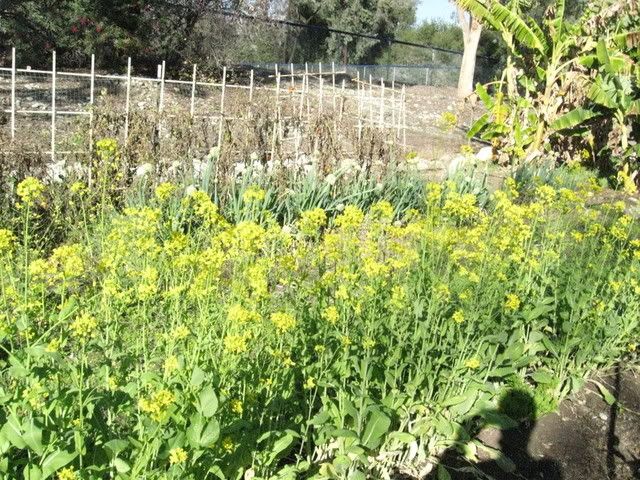
I prefer tendergreen mustards to lettuce (and use it for all of the same purposes), but they flower quickly, unlike the Giant Southern Curleds, which have a spicy taste but which flower late. One of my several successful fields of Giant Southern Curleds is pictured below.
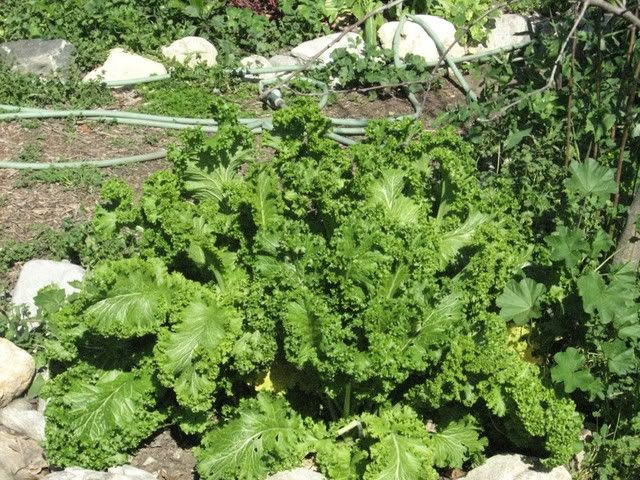
I’ve been eating a lot of these Giant Southern Curleds, as they grow like crazy. Raw they’re kind of raspy. You can cook them just a little bit for a full, rich flavor not too much unlike cooked spinach, but much better. There is also a red mustard, some of which one can find at the Farm, and a Florida broadleaf mustard, which I suspect is the variety of the huge mustard growing just north of the wooden spool at the Farm.
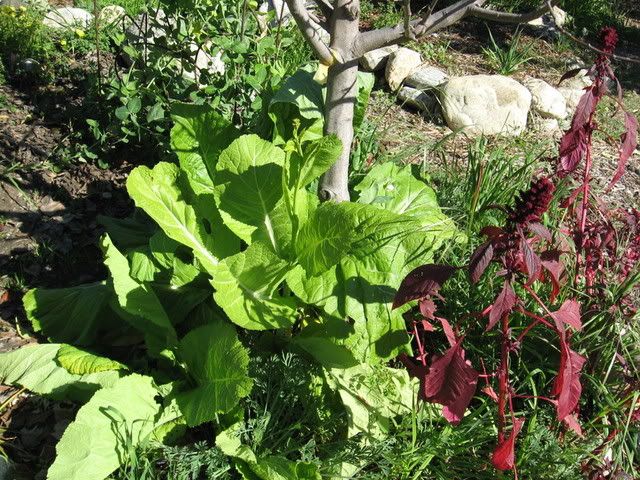
The above photo is a volunteer — at the time of this writing my own personal Florida broadleaf plantings are barely up. Yeah, you can eat that whole damn thing.

The above photo is of a red mustard embedded in another Brassica plant, looking like a cabbage or collard green. The red mustard is the one in the middle. They’re quite spicy when eaten raw.
Mustard is, of course, the name of a condiment made by crushing mustard seeds. I haven’t grown a crop of seeds yet; the tendergreens have flowered, but tendergreen mustard will not make a spicy mustard seed. More promising for condiment mustard is the Giant Southern Curled, but at the Farm the current crop hasn’t flowered yet.
There is a flour that can be made from yellow mustard, credited by the Alternative Field Crops Manual as being an “excellent emulsifying agent and stabilizer and, consequently, it is used in sausage preparation.”
There are numerous medicinal uses for mustard. Drugs.com tells us that “Mustard itself is used as a food flavoring, forage, emetic, diuretic, and as a topical treatment for inflammatory conditions such as arthritis and rheumatism. Mustard also has antioxidant activity and pharmacological effects on cardiovascular disease, cancer, and diabetes.”
A website selling “mustard rub” tells us: “Mustard seed is an ancient remedy for increasing circulation and oxygen as well as for assisting your body in eliminating acid waste and toxins.”
Mustard produces a mustard oil, which is commonly used as a vegetable oil. Mustard oil is only 5% saturated fat, making it the lowest in saturated fat of the vegetable oils (Wikipedia). However, “due to its high content of erucic acid, which is considered noxious, mustard oil is not considered fit for consumption in the United States.” There is, however, a “Mustard Project” being funded by the Department of Energy, for growing mustard “for the dual purposes of biodiesel and organic pesticide production.” As one website tells us, its “processes focused on alternating mustard crops with wheat. Once nice effect of this is that the biomass from the mustard (after harvesting the seed) could be used as the cellulose feedback for producing alcohol for biodiesel production.”
Mustard is also grown as a “green manure” crop. With “green manure” the crop is plowed into the soil to increase soil fertility. Researchers at the Fort Hall Indian Reservation in Idaho have determined that mustard green manure is an effective alternative to pesticide use in growing potatoes.
There are different varieties of mustard which should attract our interest. A variety of Brassica juncea (subspecies tatsai) is grown in Szechuan in China for its large stems, and pickled to make “Zha cai”. I have ordered Zha cai seeds from a Canadian business; if the seeds get to me in time to be planted for this season we will hopefully have Zha cai late this spring or early this summer.
There is a plant called “garlic mustard,” not technically a mustard, but of the mustard family Brassicaciae (Alliaria petiolata). Garlic mustard was imported from Europe and grows mostly on the East Coast here in the US, where it is commonly regarded as an invasive species. It is also, however, edible and (ostensibly) tasty; there are garlic mustard recipes for stir-fry and pesto that can be gotten off of the Web. This indeed represents a political dilemma; invasive species can crowd out native species, but invasive species can also have qualities we like; edible, tastes good.
The mustard project I’ve begun at the Pomona College Natural Farm is an ongoing thing; I would like to encourage the readers of this article to contribute what they can, and take what they need, from it as it continues forward and as I focus upon other plants.

18 comments
Skip to comment form
Author
Southern Calif. and remember as a little kid fields of mustard. Legend has it the Padres spread it along the El Camino Real along with the Bells to mark the trail.
I also grow it quite successfully in OR it reseeds itself in mild winters. I am discovering some great ‘weeds’ both edible and medicinal which seem to keep coming back in my yard. Years ago my husband gave me a mixture of seeds called Hot Greens and they are still reseeding and giving me spicy greens, many from the mustard family.
Thanks for the essay and great pictures. You have inspired me to go outside and sees what sprouting weed wise and other wise. Time to get to work! My goal is to turn my city size lot into a maximum cornucopia of edibles, year round if possible.
When I worked at a ‘natural area’ ,part of which was old ag field, and yes, we viewed mustards and malva (we called it cheeseweed) and lambsquarters, and horehound as obnoxious invaders, and I encouraged anyone in the area to come and get as much as they wanted, hardly anyone ever did. Staff would gather lambsquarters when it was small, but there was only so much we could eat. We never did much to assault the stuff otherwise because we had other problems like Johnson grass.
how we test and adjust our soil, we cannot grow tasty tomatoes although plenty of cucumbers and melons. I love tomatoes but I miss the ones with zing and zest when you bite into them.
Loved this diary.
my guess is mister mustard in the basement with a candelabra.
Err, that could be a different mustard come to think of it.
On a more serious note, living off the land makes a fine subject for blog posts I’m thinking – considering our circumstances. Please do more of these.
Allow me to introduce you to my friend Barry Levenson, curator of the Mt. Horeb Mustard Museum, and president of America’s mustard college, Poupon U.
photo from 40 years ago – another time, another place…
I just drove through the Napa Valley yesterday and the vineyards were in full bloom with mustard. The mustard serves as a cover crop (or green manure as you called it). It’s always lovely this time of year.
by basykes – flickr Creative Commons
Thanks for the tasty essay cassiodorius. This does seem like a very practical plant and easy to grow in urban fields & gardens too. I’m not a huge fan of bitter greens but I’ll give it another try.